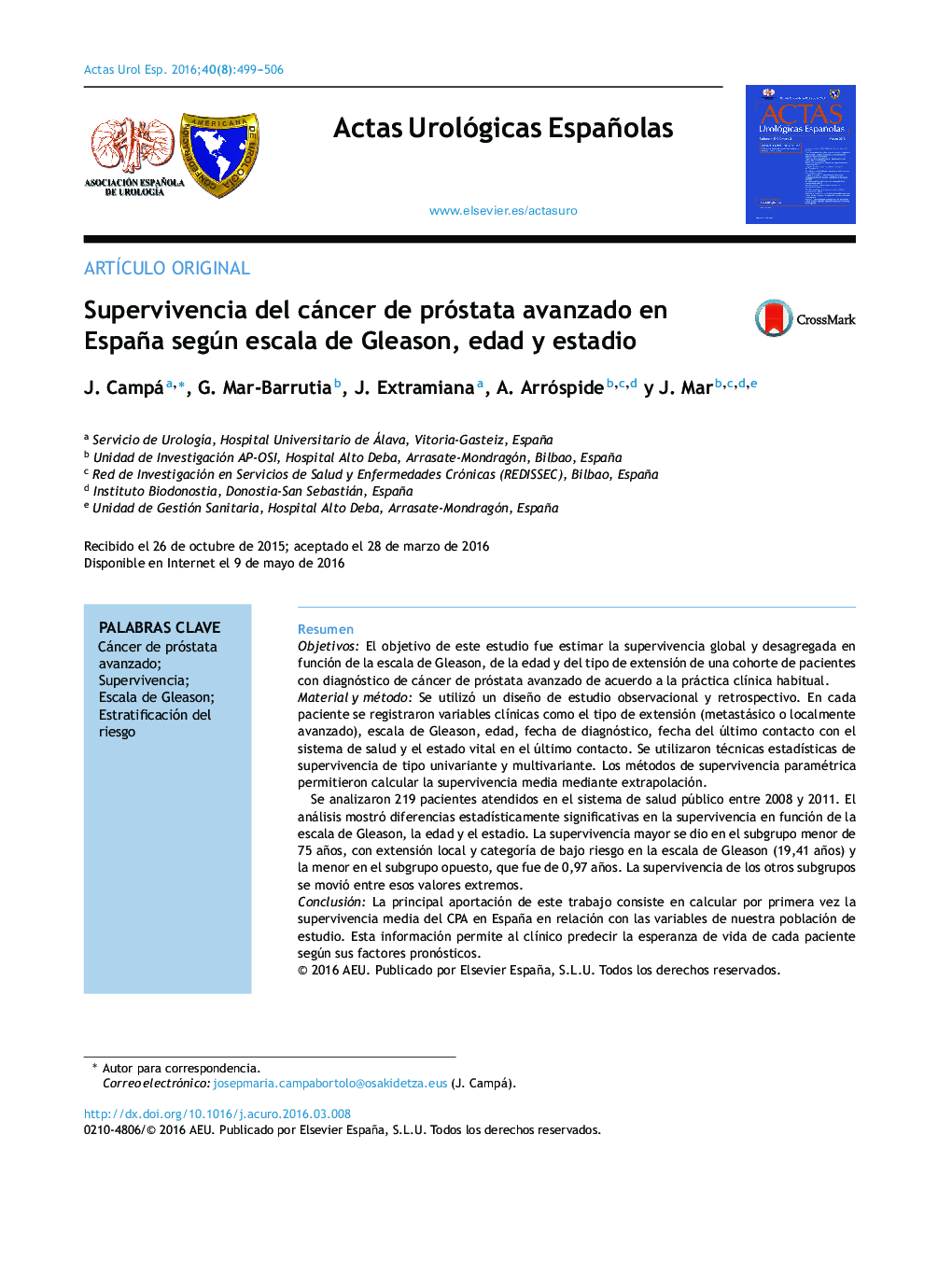| کد مقاله | کد نشریه | سال انتشار | مقاله انگلیسی | نسخه تمام متن |
|---|---|---|---|---|
| 3843055 | 1597975 | 2016 | 8 صفحه PDF | دانلود رایگان |
ResumenObjetivosEl objetivo de este estudio fue estimar la supervivencia global y desagregada en función de la escala de Gleason, de la edad y del tipo de extensión de una cohorte de pacientes con diagnóstico de cáncer de próstata avanzado de acuerdo a la práctica clínica habitual.Material y métodoSe utilizó un diseño de estudio observacional y retrospectivo. En cada paciente se registraron variables clínicas como el tipo de extensión (metastásico o localmente avanzado), escala de Gleason, edad, fecha de diagnóstico, fecha del último contacto con el sistema de salud y el estado vital en el último contacto. Se utilizaron técnicas estadísticas de supervivencia de tipo univariante y multivariante. Los métodos de supervivencia paramétrica permitieron calcular la supervivencia media mediante extrapolación.Se analizaron 219 pacientes atendidos en el sistema de salud público entre 2008 y 2011. El análisis mostró diferencias estadísticamente significativas en la supervivencia en función de la escala de Gleason, la edad y el estadio. La supervivencia mayor se dio en el subgrupo menor de 75 años, con extensión local y categoría de bajo riesgo en la escala de Gleason (19,41 años) y la menor en el subgrupo opuesto, que fue de 0,97 años. La supervivencia de los otros subgrupos se movió entre esos valores extremos.ConclusiónLa principal aportación de este trabajo consiste en calcular por primera vez la supervivencia media del CPA en España en relación con las variables de nuestra población de estudio. Esta información permite al clínico predecir la esperanza de vida de cada paciente según sus factores pronósticos.
ObjectivesThe aim of this study was to determine the overall and disaggregated survival based on the Gleason score, age and extent of a patient cohort diagnosed with advanced prostate cancer according to standard clinical practice.Material and methodWe used an observational and retrospective design for the study. For each patient, we recorded clinical variables such as the extent (metastatic or locally advanced), Gleason score, age, date of diagnosis, date of last contact with the health system and the vital status during the last contact. We used univariate and multivariate statistical techniques of survival. The parametric survival methods enabled us to calculate the mean survival using extrapolation.We analysed 219 patients treated in the public health system between 2008 and 2011. The analysis showed statistically significant differences in survival depending on Gleason score, age and stage. The longest survival was in the subgroup younger than 75 years, with a local extent and a low-risk category on the Gleason scale (19.41 years), and the shortest survival (0.97 years) was in the 75 years or older group. The survival of the other subgroups ranged between these outliers.ConclusionThe main contribution of this study is that it is the first to calculate the mean survival of advanced prostate cancer in Spain in terms of the variables of our study population. This information helps clinicians predict the life expectancy of each patient according to their prognostic factors.
Journal: Actas Urológicas Españolas - Volume 40, Issue 8, October 2016, Pages 499–506
